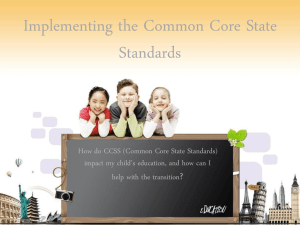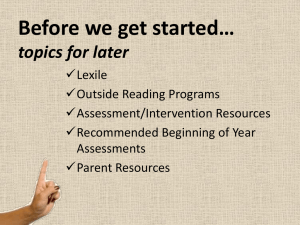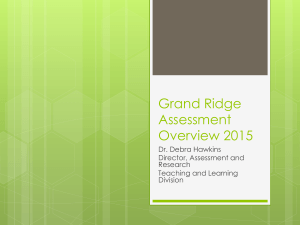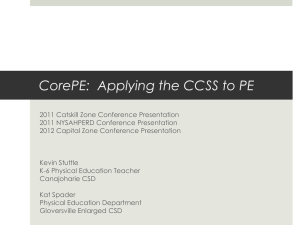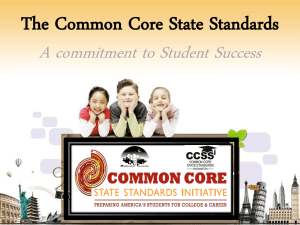Common Core State Standards
advertisement
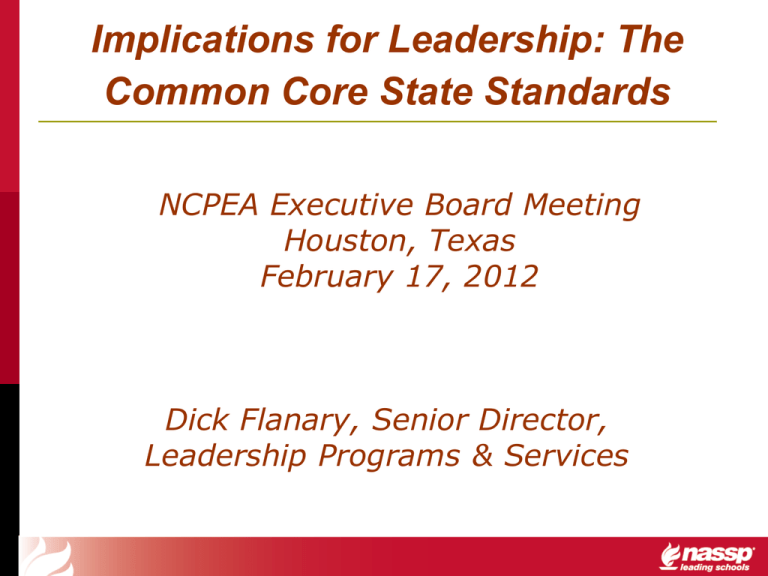
Implications for Leadership: The Common Core State Standards NCPEA Executive Board Meeting Houston, Texas February 17, 2012 Dick Flanary, Senior Director, Leadership Programs & Services Common Core State Standards A sea change that is going to require teachers to teach differently. If teachers are to teach differently, then principals need to lead differently. What is the Common Core (CCSS)? A state-led effort to develop a common set of standards in English language arts (ELA) and math that: • Align college and workplace expectations • Are rigorous and evidence-based The CCSS have been adopted by 46 states The CCSS will affect all public schools in adopted states • Implementation beginning now • New state assessments in 2014-15 A parallel effort is underway to develop Next Generation Science Standards that will be released by December 2012 3 3 The CCSS Initiative National Governors Association (NGA) and the Council of Chief State School Officers (CCSSO) convened a state-led process in 2009 to develop common ELA and Math standards. By joining the CCSS Initiative, governors and state commissioners are committing to join the state-led process. There has been increased congressional support for the CCSS (not national standards). The CCSSO and NGA joined with 49 states and territories to develop them. Partnership was also formed with Achieve, ACT and the College Board. States can include additional standards beyond the CCSS as long as the CCSS represent at least 85%. Common Core Adoptions 46 Common Core State Standards The Three C’s: College Career Citizenship 6 Key Characteristics Fewer Higher Broad Expectations Consistent Across Content Areas "Staircase of Increasing Complexity Across Grades" "Progressive Development" College, Workforce Training Expectations 7 Common Core = Major Change and Mindset Shift We need to shift our focus from high school completion to college and career readiness for all students. The Common Core State Standards: • Are for all students, not just students seeking accelerated learning. • Will impact all teachers, not just ELA and math teachers. • Is happening now. School level leaders will need to play a central role in implementing the new standards and in cultivating this mindset shift. 8 Common Core: A Fast Timeline Implementa tion is NOW! February 2012 June 2010 March 2010 Formal Release of K-12 CCSS K-12 Draft Released for Public Beginning Comment June 2009 of CCSS Initiative 9 47 States Have Adopted CCSS 2014 - 2015 Participating States Administer New CCSS Assessments Average is Over "There will always be change — new jobs, new products, new services. But the one thing we know for sure is that with each advance in globalization and the I.T. revolution, the best jobs will require workers to have more and better education to make themselves above average." Thomas L. Friedman New York Times, January 24, 2012 10 U.S. Percent of Schools Not Making AYP 100 90 80 70 60 50 40 30 20 10 0 2006 2007 2008 2009 2010 2011 Center on Education Policy. Education Week. May 11, 2011. *2012* Changing Paradigm While you slept, the national educational paradigm shifted from guaranteeing universal access to guaranteeing universal performance. Changing Demographics Globalization Alarming Dropout Rates Graduation Rates Number of Non-Graduates for Class of 2011 1,154,132 Diplomas Count. Beyond High School, Before Baccalaureate. Education Week. June 9, 2011 The Reality of Practice Accountability for principals is unlike any other profession. Whether a principal’s first day or their 10th year the level of accountability is the same. Physicians, lawyers, architects – when starting their professional practice – get mentors. Principals get tormentors. Generational Differences Technological Changes Do you remember when? Applications were sent to colleges. Linked-In was a jail. Skype was a typo. Twitter was a sound. 4G was a parking spot. Tom Friedman. Meet the Press. September 4, 2011. Almost everyone wants schools to be better, but almost no one wants them to be different. Why Common Core State Standards? Low College Completion Rates Remediation rates and costs are staggering • As much as 40% of all students entering 4-year colleges need remediation in one or more courses • As much as 63% in 2-year colleges 100% Degree attainment rates are disappointing • Fewer than 42% of adults aged 25-34 hold college degrees 80% 60% 40% 20% 0% Enter High School Graduate from High School Enroll in College Persist to Bachelor's Degree Sophomore year within 6 yrs Source: The College Completion Agenda 2010 Progress Report, The College Board 24 24 Why Common Core State Standards? More Students Need a More Rigorous Curriculum Adelman et al. (2003) 15% of students in the top quintile in academic rigor required remediation 57% of students in the bottom quintile in academic rigor required remediation Adelman (2006) 83% of students whose highest math class was calculus graduated within 8 years 40% of students whose highest math class was Algebra II graduated within 8 years 25 Why Common Core State Standards? Inconsistent State Standards 26 26 Benefits of Common Core State Standards Consistency • Previously, every state had its own set of academic standards and different expectations of student performance. Equity • Common standards can help create more equal access to an excellent education. Competition Clarity Collaboration • All students must be prepared to compete with not only their American peers, but also with students from around the world. • Clear and coherent standards will help students (and parents and teachers) understand what is expected of them. • Common Standards create a foundation for districts and states to work collaboratively. 27 27 Features of the Common Core State Standards – English Language Arts Balance between informational text and literature Comprehending complex texts Writing in response to texts Conducting and reporting on research Language and grammar skills Speaking and listening Cross-content literacy 28 Features of the Common Core State Standards – Math Emphasis on mathematical practices Attention to focus and coherence Increased focus on algebraic concepts and expressions in middle grades Problem solving and reasoning Mathematical modeling Standards for STEM readiness 29 What comes next after adoption? Changes in curriculum & instruction Understanding current alignment Implementation Professional Development Preparing for new assessments 30 Understanding Current Alignment Alignment is one of the first steps for states and districts towards implementing the Common Core. Content Alignment • To what degree does the Common Core and state standards address the same content knowledge and skills? Rigor • Are the state standards and assessments at the same level of rigor as the Common Core? Progression • Do the state standards and assessments address Common Core content at the same grade level? 31 31 Lexiles A vertical scale from zero to 2000. Lexile Lexile measures evaluate how complex a text will likely be for a reader to comprehend so that the reader can be matched with texts that best complement his or her unique ability level and reading goals. 33 2005-06 Lexile Framework® for Reading Study Summary of Text Lexile Measures Interquartile Ranges Shown (25% - 75%) Text Lexile Measure (L) 1600 1400 1200 1000 800 600 High College High College School Literature School Textbooks Literature Textbooks Military * Source of National Test Data: MetaMetrics Personal Entry-Level SAT 1, Use Occupations ACT, AP* 2005–06 Lexile Framework® for Reading Study Summary of High School Textbook Lexile Measures Interquartile Ranges Shown (25% – 75%) 1400 Text Lexile Measure (L) 1300 1200 1100 1000 900 800 ELA Math Science Social Studies Subject Area Textbooks Arts CTE Common Core State Standards – Grade level Targets Grade Lexile Target 3 800 5 950 8 1100 10 1200 12 1300 Common Core State Standards – Grade level Targets Grade Lexile Target 3 800 5 950 8 1100 10 1200 12 1300 Lexiles & Quantiles 38 www.Lexile.com www.Quantiles.com Changes in Curriculum and Instruction The Common Core will require significant curricular and instructional shifts that will impact all classrooms. Curriculum Alignment • To what degree will district and state curricula need to change to be aligned to the Common Core? Instructional Strategies • What new instructional approaches are needed to teach to these new standards? Materials and Resources • What new resources and instructional materials are needed? What resources are available? 39 39 Impact Organizational Changes Require K–12 aligned curricula "Staircase of growing complexity across all grades." 40 Professional Development To effectively implement and embrace the Common Core, rich professional development will be required. For Teachers For School Leaders • Unpacking the standards • Content-specific workshops • Assessing the standards • Cross-content literacy • Vertical teaming and vertical alignment • Observing the Common Core in the classroom • Implementing a cross-content literacy program • Building local assessments; preparing for common assessments 41 41 Impact – Big Changes 42 Know and be able to do Rigor Skill Teaching and Learning Application School Wide Impact Change the way we teach Depth over Breadth Literacy Rich Media Skills Know the answer vs. Find the answer ...and explain Engagement > MUST Research Skills 43 Common Assessments Two state consortia are building assessment systems to measure the Common Core State Standards. The assessments systems will: Provide a common measure of college and career readiness Be computer-based and include innovative item types Measure higher order skills and application of knowledge through multiple assessment formats Include formative assessments and performance tasks Provide timely data to educators and parents Ensure comparable expectations regardless of where students live 44 Assessments Target 2014 – 2015 Consortia SMARTER Balanced - http://www.k12.wa.us/smarter/ Partnership for the Assessment of Readiness for College and Careers (PARCC) http://www.parcconline.org/ New Tests Provide timely, frequent and actionable diagnostic feedback to the teachers and students to inform teaching and learning. 45 Integrative Summative/Formative Assessment System End of School Year Beginning of School Year Digital Library of Formative Assessment Materials Periodic Assessments Periodic Assessments Periodic Assessments and / or and / or and / or Project-Based Component Project-Based Component Project-Based Component Source: Education Testing Service End of Year, Course or Domain Summative Test Notable Differences between SBAC and PARCC SBAC Assess Grades 3-8, 11 One summative assessment in last 12 weeks of school year (required) PARCC Assess Grades 3-11 Selected response, short constructed response, extended constructed response, technology enhanced, and performance tasks 1. End-of-Year Assessment ELA: reading comprehension Math: machine-scorable items 2. Performance based assessment: Extended tasks Applications of concepts & skills Interim Assessments (optional) Available throughout the year Selected response, short constructed response, extended constructed response, technology enhanced, and performance tasks Computer Adaptive assessment Two summative assessments close to end of school year (required) Two Formative assessments (optional) 1.Beginning of year 2.Mid-Year Computer-based but a single form for all students. Paper & pencil for grades 3-5 (initially). ELA Impact 48 Raises text complexity at least 2 years Vocabulary –All teachers must teach the academic vocabulary of their discipline. Significant impact at high schools Critical Reading Expect all students to respond in complete sentences Informational Texts vs. Narrative Writing Speaking Listening Textbooks are outdated Cross-Content Literacy Math Impact Conceptual Understanding Algebra – Grade 8 Significant impact for retraining elementary teachers in mathematics. Statistics & Probability 49 Assessment Impact Technology Dependent Hardware Logistics Bandwidth 50 Recommendations for Schools Begin PD today School wide literacy K–12 Alignment Writing Multi-tiered interventions Student Engagement Transparent Practice Questions for NCPEA How does the CCSS impact principals preparation? What responsibility does NCPEA have for getting principals ready to lead CCSS implementation? Resources The Common Core State Standards Initiative: http://www.corestandards.org/ SMARTER Balanced: http://www.k12.wa.us/smarter/ Partnership for the Assessment of Readiness for College and Careers(PARCC): http://www.parcconline.org/ 53 Contact Information Dick Flanary NASSP Senior Director, Leadership Programs and Services 1904 Association Drive Reston, Virginia 20191 flanaryd@nassp.org 800-253-7746 Ext. 294 www.nassp.org
